The Biceps Brachii (commonly called the biceps) is a muscle located at the front of the upper arm and attaches your arm bone (humerus) to your shoulder. It is the muscle that bumps up when you flex your arm and it functions to rotate your arm from pronation to supination (twist your palm upward), and to bend your elbow and shoulder.
Biceps tendons are strong, cord-like structures that connect the upper end of the biceps muscle to the bones in the shoulder. The biceps tendons and muscle, help you to bend your elbow and rotate your arm. They also keep your shoulder stable and your arm centered in your shoulder socket.
Biceps means 'two heads' in latin and the muscle earns its name because it joins at the shoulder in 2 places with 2 different 'heads'.
These "heads" are known as the proximal biceps tendons because they are closest to the top of the arm. The short head of the biceps tendon originates at the coracoid process of the scapula (shoulder blade). The long head of the biceps originates just above the glenoid fossa (joint cavitiy) of the scapula (shoulder blade) and runs in front of the head of the humerus along the bicipital groove, like a rope through a pulley. The transverse humeral ligament runs over top of the long head biceps tendon, holding it against the humeral head. The 2 heads of the biceps then merge and go down the length of the upper arm. It attaches at the largest part of the radius (lower arm bone) at the elbow.
Both heads of the biceps muscle are attached to the shoulder bones with their respective tendons. These tendons can become irritated and inflamed from a strain or from overuse of the tendon. As a result, tendonitis, tenosynovitis or a biceps tendon rupture may occur.
Biceps brachii tendon damage, inflammation, strain, or a tear typically affects the long head tendon of the biceps, as it is much more involved with the biceps group of muscles and tendons. The biceps is a commonly injured area of the body due to the large range of motion and frequent use of the shoulder joint.
Biceps tendinitis, or bicipital tendinitis (also spelled tendonitis), is a painful condition that affects the fibres of the biceps brachii tendon. Tendinitis occurs when the biceps tendon experiences small tears, is irritated, and becomes inflamed. As tendonitis develops, the tendon shealth (covering) can become thicker due to the tough scar tissue that builds up during healing. This thickening makes the tendon less flexible and prone to further injury.
Biceps tendonitis causes pain in your arm and/or shoulder and may lead to more severe problems if left untreated. The tendon and its sheath can become bound together, a condition known as adhesive tenosynovitis, which can severely restrict the range of motion within the arm and shoulder. The walls of the tendon sheath can thicken which prevents the tendon from sliding through the opening that keeps it in place, a condition known as constrictive tenosynovitis. The bicep tendon can rupture, or tear, completely which may require surgery.
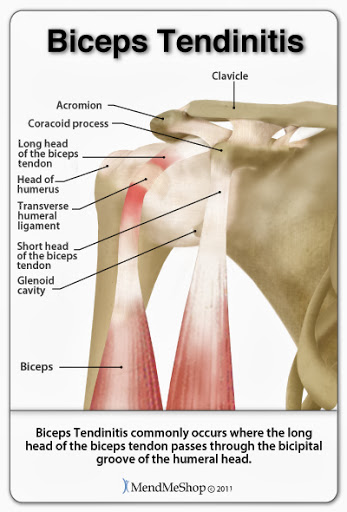
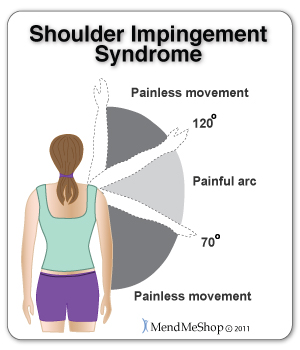
Biceps tenosynovitis is a common tendon injury that typically affects older athletes. If you are diagnosed with this, it means that the synovial sheath (outer covering) of the biceps brachii tendon has become inflamed and swollen. The swelling limits the biceps tendon's ability to slide through the sheath smoothly and can cause scar tissue to build up between the tendon and its sheath restricting movement even more.
There are two biceps tendons located on the front side of your upper arm and shoulder. The long head biceps tendon attaches to the top of the shoulder socket (glenoid). The short head of the biceps tendon attaches to a bump on the shoulder blade called the coracoid process. On the other end of your bicep there 1 tendon that attaches your muscle to the radius bone at the elbow.
If you are suffering from bicep tendonitis you will have pain in the front of your shoulder and some tenderness / weakness in your bicep muscle. Pain will increase as you lift your arm overhead, raise your arm in a throwing motion, or pull on something with your arm. You may have pain and a deep achy-ness in the shoulder that moves down the front of your arm, and in some cases, radiate down to the hand. Sometimes snapping can be heard or felt in the shoulder.
Pain from biceps tendinitis may worsen at night - especially if you sleep on the arm that has been affected with the biceps tendinitis.
If you have biceps brachii tendonitis or tenosynovitis you may experience:
With bicep tenosynovitis you may also experience:
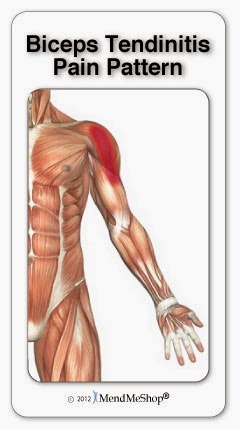
With a biceps tendon rupture:
Due to the biceps muscle's connection to the shoulder joint, other problems that may occur in conjunction with biceps tendonitis include injuries such as shoulder impingement, shoulder instability, tears in the glenoid labrum that can lead to frozen shoulder, arthritis, and rotator cuff tendon tears.
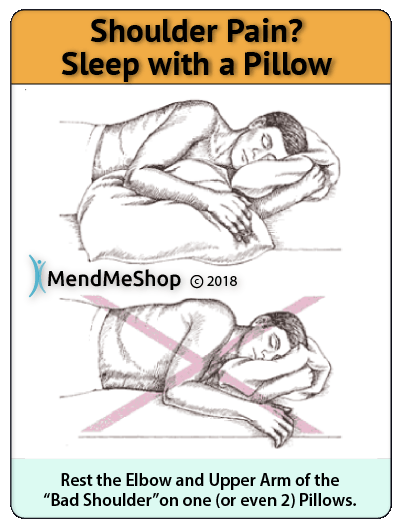
Tendinosis is basically like tendonitis but it's not caused by an injury. Tendinosis is caused by chronic degeneration (wearing away) of tendon fibers over time. This is a natural thing that happens to our tissue as we age.
Tendonitis basically means damage or micro-tearing to your tendon whereas Tenosynovitis is damage or micro-tearing to the sheath covering your tendon. This sheath is a protective lining for your tendon and is made up of synovium. If this sheath is injured it can also become irritated resulting in similar symptoms as tendonitis (pain, swelling and inflammation).
It's possible for you to have tendonitis / tendinosis AND Tenosynovitis at the same time creating a more complicated bicep tendonitis injury.

In the majority of cases, wear and tear of the biceps tendon causes damage. This wear and tear is often due to overuse of the shoulder doing the many overhead activities that we perform in our daily lives, hobbies, and sports. Relevant repetitive actions are common in athletes or workers who use frequent overhead arm movements such as throwing a ball, swinging a racket, swimming, martial arts, lifting weights, dusting high shelves, painting, or completing manual labor tasks. Biceps Tendonitis can also occur because of a sudden, serious injury to the tendon.
Anyone can suffer from biceps tendinitis, but it's most common in adults due to degeneration of tissue as we age. Over time the tendons in the arm will wear down resulting in something called degeneration. This is where the fibers in your tendons will become weaker - it's just a natural process that happens as we age.
Biceps tendinitis often occurs with other shoulder conditions or injuries, usually with damage to the biceps tendons. A fall on an outstretched hand or a direct blow to the shoulder can cause acute tendonitis (tendinitis that comes on quickly) if the biceps tendon is damaged. If left untreated, both types of tendinitis may develop into tenosynovitis or a complete tear (rupture).
Specific causes of biceps tendonitis, tenosynovitis, and tears in the biceps tendon include:
Your shoulder and arm connect into one ball-and-socket joint, involving 3 bones, and a large number of muscles, tendons, ligaments, connective tissues and synovial fluid. Biceps tendonitis usually occurs along with other shoulder related problems:
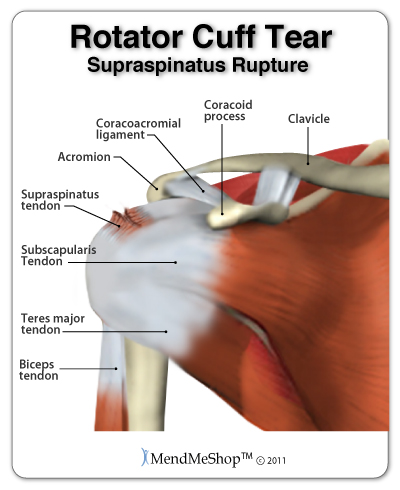
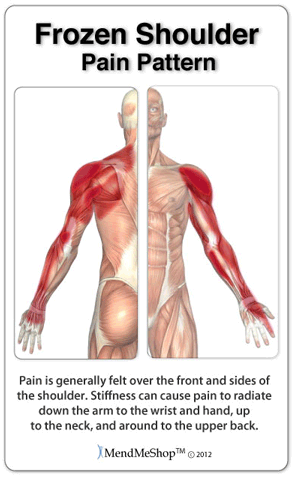
Visiting your doctor when you have arm pain is always recommended, as there are many possible issues that can happen within the arm and shoulder joint.
To begin with, your doctor will gather a medical history about you and your current condition and symptoms. They will ask about the intensity of your pain, how long your symptoms usually last and the limitations you're experiencing. Details about when it started and whether or not you have ever had treatments for this or a similar condition in the past are very helpful in assessing your shoulder injury.
Your doctor will also look and feel the bones and soft tissue in both your shoulder and arm to find any differences between you injured arm/shoulder and your healthy arm/shoulder. This will help them to feel any abnormalities in and around your shoulder - like mild or severe inflammation, bone deformities, atrophied muscles (muscles that have wasted away due to injury), redness and/or warmth on the skin.
Speed's test: Your doctor will press down on your arm as you hold it out with your elbow slightly bent and palm up.
Yergason's test: Your doctor will grip your hand and apply pressure on your arm while you bend your elbow 90 degrees (at a right angle).
For both tests pain in a specific area of the shoulder during will let the doctor know that you have biceps tendinitis.
Sometimes, one set of symptoms can result in multiple diagnoses. An X-ray, CT scan, MRI or visual ultrasound is often needed in order to diagnose if the area is out of alignment or the extent of the soft tissue damage.
It's important to have a proper diagnosis from a doctor or some other medical professional to determine the cause of your symptoms. This way the right treatment can be used to treat the condition and relieve your pain.
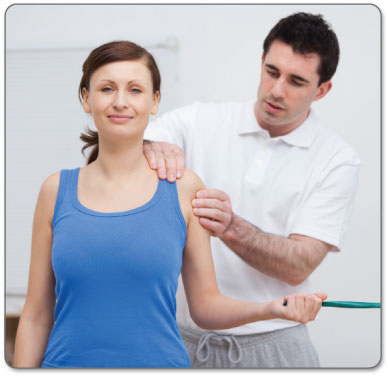
In most cases, your Doctor will start with non-surgical treatments options. Some of the options your doctor may recommend include drugs or medications like NSAIDs (non-steroidal anti-inflammatory drugs) to manage pain and inflammation. Steroid injections are advised with caution for any type of tendon condition as there is increased risk of tendon rupture.
(reference: American Academy of Orthopaedic Surgeons)
The good news is that most cases of biceps tendinitis will heal with simple home conservative treatments and surgery is often not needed. You will find that conservative treatment for most tendon strains are very similar to treatments recommended for a muscle strain. Do NOT underestimate the importance of healing tendon injuries quickly and completey! A seemingly small, nagging injury in your shoulder that's not properly treated can lead to a chronic painful degenerative shoulder injury that can persist for years if not properly treated.
If the tendon injury is very recent - use a good quality cold pack and Arnica Pain Relief Cream. If the injury has been going on for awhile and there is little to no swelling or inflammation, skip to Step 2 below.
Inflammation is the body's natural response to an immediate shoulder injury and is a normal part of the healing process - helping to reduce tissue infection in the early stages of injury. Swelling, pain, heat sensation, redness, and loss of function are the main symptoms experienced.
The combination of rest, topical pain relief cream and minor amounts of cold is the gold standard in medicine for minimizing tissue damage and reducing inflammation after injury or activity. It serves as a critical bridge into the next phase of the healing process.
Tendons,ligaments, cartilage, and some muscle fibres are dense tissues. As a result, they naturally receive limited blood flow and this is precisely why injuries to these tissues take so long to heal. The challenge is, how do you effectively increase blood flow to these tissues?
It is through the blood that the body carries nutrients and oxygen that injured tissue relies on for good health.

The TShellz Wrap® is a localized circulation booster - blood flow help maximize the body's ability to heal while clearing the area of toxins and excess fluid build up, thereby reducing inflammation.
We recommend the use of a TShellz Wrap®:
TShellz Wraps® contain a unique Carbon Fiber Energy Pad which is flexible and will shape to conform to your body. This Energy Pad emits a uniform wave of perfectly safe energy over its entire surface. This energy is absorbed by soft tissue in the treatment area, opening blood vessels, resulting in an increase in blood flow. Increased blood circulation is what your body needs to accelerate the healing of soft tissue and this is why we recommend the TShellz Wrap®.
The TShellz Wrap® is an FDA Registered Medical Device and is suitable for use in therapeutic clinics and FROM HOME. It is completely safe for people and patients to use for themselves.
The technology found in a TShellz Wrap® has been used for decades in the worlds of professional and amateur sports - a contributing factor as to why athletes seem to recover from injuries so quickly.
Have you ever wondered by an athlete can return to activity after 3 or 4 weeks following a soft tissue injury - while your average person takes much longer to return back to normal? The secret isn't really that much of a secret - it involves consistent treatments (meaning multiple times a day) using a treatment like the TShellz Wrap® to stimulate blood flow to the injured tissues. Most athletes have the luxury of using in-house facilities many times per day.
How many us can afford the time and money to visit a clinic multiple times a day? Very few indeed. This is how you can gain some of the advantages that athletes enjoy in their injury recovery - by using a device like the TShellz Wrap® two or three times a day on a consistent basis.
We believe the TShellz Wrap® to be one of the most effective home treatments to increase localized blood flow in and around the treatment area.
We can promise that you will receive a product that is designed to be safe and does what it is supposed to do... reduce pain (as stated in "Therapeutic Heat and Cold", 4th edition. - Ed. Justus F. Lehmann, M.D., Williams, and Wilkin) temporarily increase length & flexibility of soft tissue (as stated in "Therapeutic Heat and Cold", 4th edition. - Ed. Justus F. Lehmann, M.D., Williams, and Wilkin) and aid your body in recovering from tendon, muscle and other soft tissue injuries via enhanced blood flow.
The unit plugs into a standard wall outlet to get its power. The nice thing about the power supply is that the same unit can be used in North America and overseas as well. It has the capability to operate between 110v and 230v.
The TShellz Wrap® has a special signal controller that can be set for 3 different power levels of application (3=High, 2=Medium, 1=Low). The cord is long enough that you can sit or lie comfortably and watch TV, read or surf the net while you're using it.
Treatments are max 30 minutes in duration and the device can be worn over clothing. This allows you to use the device at work, at home, or really anywhere you have access to an electrical outlet.
The most common question we receive from individuals prior to purchasing is - how many times a day should I be using my wrap and when should I be using them? While treatment plans will differ for each individual and their specific injury, there are general guidelines that should be adhered to.
The TShellz Wrap® would then be used:
Dealing with aches and pains affecting the foot, ankle, leg, knee, hamstring, hip, back, arm, shoulder, elbow, wrist, or hand? If so, then applying the Arnica Infusion to any of these targeted areas will bring about fast relief from the pain and sore tissues. Simply apply a small amount of cream to the body and moments later, you will experience a soothing and comforting sensation over the area.
Arnica Infusion is specially designed to relieve pain due to sore muscles and joints associated with arthritis, backaches, sprains, strains, and bruises. No matter if you are dealing with an acute injury, chronic pain, or a general "flare-up" - you will experience fast relief from pain and inflammation.
This is a product that many of our current MendMeShop customers asked us to develop. So we focused our time and resources over the past few years and came up, with we believe, will be one of more effective, fast acting, topical pain relief creams on the market.
You are likely familiar with some of the standard topical agents on the market as most of our customers use them. The are mass marketed and even found in most department stores now.
Well, we are here to say that Arnica Infusion goes many steps beyond what they offer.
Made in the USA at an FDA registered manufacturing facility, you can be assured that Arnica Infusion is both safe and effective. We only source top grade ingredients while implementing strict quality control checks during every step of the production process. Expect the same high quality that MendMeShop customers have been accustomed to since we started the company in 2005.
The "Cool Blue" formula is the perfect balance between the smooth application of a cream and the effective absorbing factor of a gel. It is not too thick and not too thin - just the right texture. Best of all, it feels very nice on the skin!
Each application of Arnica Infusion feels so comforting and soothing, we are certain it will become an item you will not want to live without.
The Arnica Infusion formula is based on a combination of scientific research and the use of high quality ingredients. The properties within the formula were chosen for their pain relief, anti-inflammatory, and soothing qualities.
The acting ingredients within the formula include ones many of us are familiar with; along with ones that have not received a lot of publicity (only in research circles). Extensive testing resulted in a blending of ingredients that provides the most synergistic of benefits.
The notable ingredients in the Arnica Infusion formula include:
Extensive quality control procedures during the manufacturing process ensure the ingredients and final product are both safe and effective. We would not stake our reputation on anything but the best.
Apply Arnica Infusion at work to help reduce acute discomfort associated with overuse of muscles and joints. No matter if you are in a physical demanding job or work within an office environment, you will be placing stress on different parts of the body and aches and pains will result.
If you suffer from a sprained ligament, pulled muscle, strained tendon, or even bruising - apply Arnica Infusion for quick relief of the pain.
Application of Arnica Infusion can be done up to a maximum of 4 times per day on a consistent basis to help bring about relief from various pains and aches.
Follow up your TShellz and Cold treatments with an application of Arnica Infusion. Combine the pain relieving benefits of Arnica Infusion along with the therapeutic benefits of the wraps to make your recovery go much more smoothly.
Do not apply Arnica Infusion within a 2 hour timespan before a TShellz Wrap® treatment.
Whether you decide to use the Arnica Infusion in conjunction with the T-Shell and other treatments - or if you decide to use the cream as a stand-alone product - you will not be disappointed with the results. We guarantee it.
Conservative treatment tools just like these have been used successfully by thousands of soft tissue injury sufferers - just like you.
We believe the use of TShellz® Circulatory Boost Wraps for boosting blood flow to soft tissue in the area of application is one of the most under-utilized home treatment options available on the market today. We have client after client that have tried many options out there and have been amazed at how effective and fast the TShellz Wrap treatment can relieve pain and increase blood flow in the treatment area.
With regular use of the TShellz® Circulatory Boost Wrap:
*Know that every personal soft tissue injury is unique and the TShellz Wrap may not work for everyone. This is why we offer a 60-day money back return on all our TShellz Wrap devices.
Since you are reading this, you probably know that serious tendonitis or tendinosis injuries do not just disappear. Over time, they usually wreak havoc on other joints in the body due to lack of movement and over-compensation. Recovery takes a longer time for such chronic (long term) injuries, but proper healing is essential to regain strength and get you back to the activities you enjoy.
The longer your injury endures, the greater the risk of running into serious overcompensation injuries.
Anyone in need of rapid recovery and complete healing must consider a comprehensive treatment plan that includes an effective means to minimize swelling and inflammation yet also stimulate healing and tissue elasticity. We have found no better set of tools that can be used at home than this:
Conservative treatment tools just like these have been used successfully by thousands of soft tissue injury sufferers - just like you.
We believe the use of TShellz® Circulatory Boost Wraps for boosting blood flow to soft tissue in the area of application is one of the most under-utilized home treatment options available on the market today. We have client after client that have tried many options out there and have been amazed at how effective and fast the TShellz Wrap treatment can relieve pain and increase blood flow in the treatment area.
These tools are what you need for rapid healing. These are the tools that top professional athletes use to treat their injuries every single day. And just like these athletes, you can treat yourself at home. If you are suffering from any form of tendinopathy or you're recovering from soft tissue surgery, you can heal quickly if you treat your injury correctly. That means using the right therapies every single day.
With regular use of the TShellz® Circulatory Boost Wrap:
*Know that every personal soft tissue injury is unique and the TShellz Wrap may not work for everyone. This is why we offer a 60-day money back return on all our TShellz Wrap devices.
*Know that every personal soft tissue injury is unique and the TShellz Wrap may not work for everyone. This is why we offer a 60-day money back return on all our TShellz Wrap devices.
Doctors and Surgeons are always improving the techniques used in surgery, and results from surgery now are much more positive than they were in the past. However, all surgeries introduce scar tissue, and recovery from surgery can be less than ideal and take longer than anticipated.
If you do wind up getting surgery, know that rehabilitation at-home while attending regular doctor appointments or clinic visits is vital for your overall recovery.

Consistent exercise and conservative treatment on a daily basis during your rehabilitation while working with your doctor or physical therapist is key. This is why you should seriously consider maximizing your recovery by using the TShellz Wrap® at home once you are approved for PT.
The more consistent you work at enhancing blood flow to surgically repaired soft tissue, the more consistent the healing process will be. Nourishing the tissues will more oxygen and nutrients (which are carried through the blood stream) will give the body a better ability to produce new, healthy collagen. In effect, you will help the body produce stronger tissues while potentially reducing the number of setbacks that can occur following surgical procedures.
Shortened muscles and tendons due to lack of use is a real problem during recovery. When you start to feel better and use the joint, shortened muscles and tendons get over-strained, introducing small microtears. These microtears start the formation of scar tissue, which unlike muscle or tendon, is completely inflexible. Once there is scar tissue in there, tears will generally increase with movement; eventually you've got a serious problem with a joint that does not flex as much as it did before and this becomes a chronic condition. You'll know you have scar tissue when you get shooting pain if you stretch your joint too far... it is something that physical therapist's deal with quite often.
To help prevent this, use a TShellz Wrap before undertaking significant activity, as heat is known to increase the length & flexibility of muscles, tendons and ligaments. This is actually why we advise plantar fasciitis sufferers to treat themselves with a Plantar TShellz Wrap first thing in the morning before walking (walking stresses the plantar ligament on the bottom of the foot). After treatment, the plantar ligament is more flexible and can handle higher walking stresses before it starts to micro-tear. The ability for soft tissue to stretch further before micro-tearing will allow you to gently stretch your recovering joint without re-injuring it yet again. This is a huge boon for recovery.
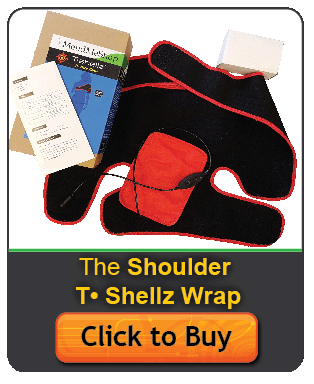
We all know that if the injury was healed, the pain would go away but what about the opposite situation? If the pain is gone, does that mean the injury is better? Unfortunately, this is not always true.
Too many people only focus on suppressing pain symptoms while providing less attention to the true healing aspects of the body. Experiencing less pain, while obviously a good short-term goal, does not equate to underlying healing. Scar tissue can remain for months after one gets to a point of being relatively pain-free. However, as long the weak and brittle scar tissue remains, you are susceptible to re-injury or re-aggravation. Certain motions or movements can cause the weaker tissue to easily tear - resulting in some reversal of the recovery up until that point.
This is why we recommend for people to continue with their doctor or therapist recommended exercises and to continue with mild treatments of the TShellz Wrap® for a period of time - to better ensure complete recovery.
Ongoing treatments to enhance circulation are intended to soothe, relax and promote healing of damaged soft tissue in the application area. T•Shellz treatment also results in the ability of soft tissue to extend further due to the effect of heat on soft tissue. The more extensible your tissues are, the less likely they are to strain or sprain.
People tell us all the time, "I was told that if I stay off my feet for a few weeks, my pain will disappear for good."
The truth is, tendonitis pain is usually a culmination of numerous factors, such as repetitive stress, poor posture, acute injuries, and overcompensation issues resulting from other muscle and soft tissue ailments.
It may take weeks or months for these pain triggers to surface. When they , however, merely resting will solve the underlying issues. You need to utilize actions and options that actually treat the source of the pain and help reverse the damage that has been done.
Resting has a role to play, but it is only one small factor in a recovery plan.
AidYourTendon advisors do not work on commission, so be assured you will only receive fair and objective information.
Remember: We recommend that you consult your doctor and/or physiotherapist before using any of our outstanding products, to make sure they're right for you and your condition.
Product Advisors are available 9:00 am to 5:00 pm Eastern Standard Time Monday to Friday.
I want to learn more about Post-Surgery Recovery
I want to learn more about TShellz Wrap® Circulatory Boost
I want to learn more about Ice & Heat: Which Is Better For Treatment?
I want to learn more about Tendonitis Treatments
I want to learn more about Tendonitis Surgery
During your recovery, you will probably have to modify and/or eliminate any activities that cause pain or discomfort at the location of your soft tissue injury until the pain and inflammation settle. The more diligent you are with your treatment and rehabilitation, the faster you will see successful results!
Please be aware that this information is neither intended nor implied to be a substitute for professional medical advice. CALL YOUR HEALTHCARE PROVIDER IMMEDIATELY IF YOU THINK YOU MAY HAVE A MEDICAL EMERGENCY. Always seek the advice of your physician or other qualified health provider before using any of our outstanding products to make sure they are right for you and your condition or if you have any questions regarding a medical condition. Always see your doctor for a proper diagnosis as there are often many injuries and conditions (some very serious) that could be the cause of your pain.
© 2025 In.Genu Design Group, Inc. Contact Us